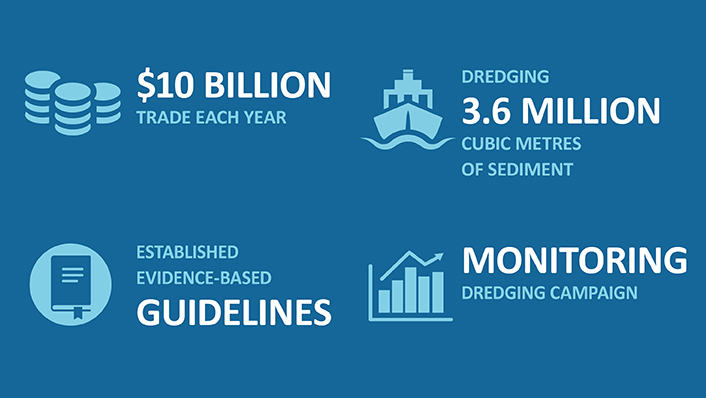The challenge
The Port of Townsville is the largest multi-cargo port in northern Australia, handling more than $10 billion in trade each year. The Port is located in Cleveland Bay, a shallow embayment in North Queensland waters and is part of the Great Barrier Reef World Heritage Area. The Port of Townsville undertakes regular maintenance dredging under state and federal government approvals in Cleveland Bay to maintain navigable areas for safe shipping operations.
Dredging at the Port of Townsville occurs generally between a period of five to six weeks each year to remove naturally accumulated sediment in port infrastructure. Dredging can produce suspended sediments around the dredge vessel which has the potential to reduce the quantity of light reaching corals and other photosynthetic life living on the seafloor until the plume dissipates. Dredge plumes can travel varying distances depending on a range of factors, (e.g. wind speed/currents).
We do not know how corals tolerate low light in turbid inshore environments where dredging occurs and as such monitoring light during dredging activities could provide information on how to best manage the process.
The approach
AIMS scientists measured how light levels decrease underwater as depth increases, and how sediment plumes created by a trailer suction hopper dredge undertaking maintenance dredging affect light loss. They also analysed several years of light data collected on local reefs which included many natural sediment resuspension events from storms or high winds.
These studies quantified how suspended sediments lowered underwater light levels. They also showed that the sediments changed the light colour, reducing blue wavelengths, making it greener and less useful for photosynthesis.
Corals and sponges grown in the National Sea Simulator at AIMS were then used to recreate the same conditions of suspended sediments and changing light quantity and colour. Corals and sponges were monitored under these conditions for many weeks.
The impact
The results highlighted the importance of light quantity and colour to corals and sponges and led to locally relevant values for underwater light in Cleveland Bay.
The Port is including the findings from this work in monitoring programs for maintenance dredging and also for the Channel Upgrade Project, which will undertake capital dredging of the shipping channel as part of the Port’s 30-year Port Expansion Project. The Channel Upgrade Project has incorporated telemetered underwater light sensors as part of its monitoring program, so that real time light data can be used to guide decisions and adaptive management for dredging activities.
The AIMS research has made a valuable contribution to local knowledge on Cleveland Bay and inshore environments.
The study was supported by the Tropical Water Quality Hub of the National Environmental Science Program, AIMS and the Port of Townsville Ltd.


